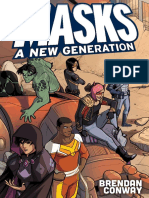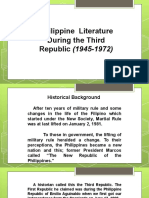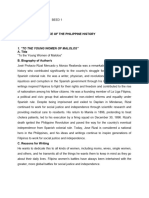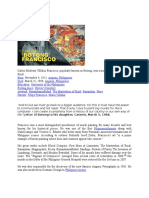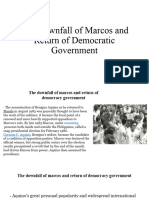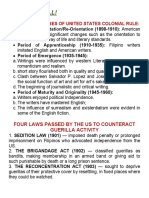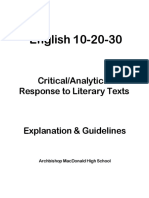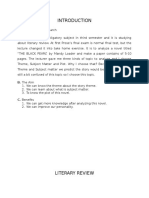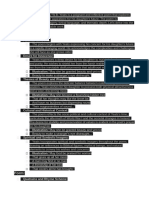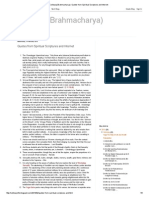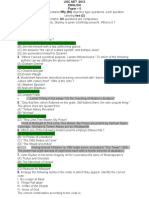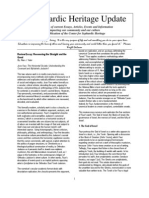Famous People From Peru: 3° Idiomas
Famous People From Peru: 3° Idiomas
Uploaded by
María Luz Alpaca RodriguezCopyright:
Available Formats
Famous People From Peru: 3° Idiomas
Famous People From Peru: 3° Idiomas
Uploaded by
María Luz Alpaca RodriguezOriginal Title
Copyright
Available Formats
Share this document
Did you find this document useful?
Is this content inappropriate?
Copyright:
Available Formats
Famous People From Peru: 3° Idiomas
Famous People From Peru: 3° Idiomas
Uploaded by
María Luz Alpaca RodriguezCopyright:
Available Formats
3 Idiomas
FAMOUS PEOPLE FROM PERU
JORGE MARIO PEDRO VARGAS LLOSA (March 28, 1936) He has been politically active throughout his career; over the course of his life, he has gradually moved from the political left towards liberalism or neoliberalism, a definitively more conservative political position. While he
initially supported the Cuban revolutionary government of Fidel Castro, Vargas Llosa later became disenchanted with the Cuban dictator and his authoritarian regime. He ran for the Peruvian presidency in 1990 with the center-right Frente Democrtico (FREDEMO) coalition, advocating neoliberal reforms, but lost the election to Alberto Fujimori. JULIO CSAR TELLO (April 11, 1880 June 3, 1947) He was a Peruvian archaeologist. Tello is considered the "father of Peruvian archeology" and was America's first indigenous archaeologist. He made the major discoveries of the prehistoric Paracas culture and founded a national museum of archeology. The Julio C Tello Museum on the Paracas Peninsula is named in his honour. After the reserve was established in 1975, the museum was built to house artifacts and
3 Idiomas
interpret the archeology and culture of the Paracas, as well as the rich natural life of the marine reserve. JOS SILVERIO OLAYA BALANDRA (1789 June 29, 1823) He was a Peruvian cultural figure and fighter for the independence. He is remembered for the enunciation of his clear political position towards independence with his declaration "If I have a thousands lives, I would give them very glad before reject my country..." In the fight for the independence of Peru, Olaya participated as a secret emissary, taking messages between the government (Callao) and the patriotic ones (Lima). Because he was well known for his ability to swimm long distances; he was recruited by the He was caught, torture and sentenced to death; in spite of the tortures, he never revealed his JOS MARA ARGUEDAS ALTAMIRANO (18 January 1911 28 November 1969) He was a Peruvian novelist, poet, and
anthropologist. Arguedas was a mestizo of Spanish and Quechua descent who wrote novels, short stories, and poems in both Spanish and Quechua . Generally remembered as one of the most notable figures of 20th century Peruvian literature, Arguedas is especially recognized for his intimate portrayals of indigenous Andean culture. Key in his desire to depict indigenous expression and perspective more authentically was his
3 Idiomas
creation of a new language that blended Spanish and Quechua and premiered in his debut novel Yawar Fiesta DANIEL ALCIDES CARRIN (August 12, 1857 October 5, 1885) He was a Peruvian medical student after whom Carrion's disease is named. He described the disease in the course of what proved to be a fatal experiment upon himself in 1885, in order to demonstrate definitively the cause of the illness. He was inoculated by close friends with blood from a wart between the eyes of a 14year-old patient. His aim was to prove a link between the acute blood stage of Oroya fever with that of the later chronic form of the disease
Verruga Peruana typified by numerous red wartlike dermal nodules. Neither the cause nor mode of transmission of Oroya fever was then known and, furthermore, the relationship between the acute and chronic forms of the disease was not proven. CARLOS NORIEGA (October 08, 1959) Astronaut. Born on October 8, 1959, in Lima, Peru. Noriega grew up in Santa Clara, California. While in college, he was a member of the U.S. Navy's Reserve Officers' Training Corps. After graduation, Noriega received a commission with the U.S. Marine Corps and went to flight school. He had several
3 Idiomas
different assignments, including flying helicopters at the Marine Corps Air Station in Kaneohe Bay, Hawaii. In 1990, Noriega earned two master's degrees?one in computer science, the other in space systems operations?from the Naval Postgraduate School in Monterey, California. He then went to work at the United States Space Command in Colorado Springs, Colorado. He was selected for Astronaut Corps by the National Aeronautics and Space Administration (NASA) in 1994. About a year after completing all of the necessary training, he went on his first space shuttle mission in 1997. As a member of the crew of the Space Shuttle Atlantis, he conducted experiments and visited the Russian space station Mir space. His second mission was in 2000, which was dedicated to building the International Space Station. Retired from the Astronaut Corps in 2005, Noriega continues to work at NASA as the manager of advanced projects office in the constellation program at Johnson Space Center. He is married and has five children. MARIANO MELGAR (August 10, 1790 Maech 12, 1816) Mariano Melgar was born in Arequipa on August 10, 1790, to Don Juan de Dios Melgar and Doa Andrea de Valdivieso, members of distinguished families of the time. At a young age he demonstrated a gift for writing poetry and in his later years he was said to have fallen in love with Mara Santos Corrales, whom he romantically mentioned as Silvia in his poetry writings. The girl was said to be nine years his junior and her parents opposed their relationship. In 1814, the revolution of Mateo Pumacahua took place in Cusco, which upset the apparent tranquillity
3 Idiomas
of the Spanish viceroyalty of Peru and prompted Melgar to join the independence because and march to combat. After winning the combat of Apacheta in Arequipa, the army marched towards Puno and fought the Battle of Umachiri, in which Melgar fought bravely directing the revolutionary army's artillery. The patriots were defeated and made prisoners, including the young Melgar. The Spanish General Ramirez, after holding Melgar captive for some time, ordered his officers to place him before a firing squad. Melgar died in the morning of March 12, 1815, just before turning 25. JUAN PABLO VIZCARDO AND GUZMAN (Pampacolca, 1748 London 1798) J esuit priest and intellectual. He entered the Jesuit order in 1763. Left Peru in 1767 when exiled with his order. He went into exile in Italy, from where he tried to support the separatist cause American. Established relationships with the British to support the cause of independence, without success. In 1792 he wrote the letter to the Spanish Americans to mark three centuries of the discovery of America, where he called criollos to gain independence from the metropolis.
FERNANDO BELANDE TERRY (October 7, 1912 June 4, 2002) The second of four children, Belande was born in Lima into an upper-class family of Spanish forebears. His father, Rafael Belande Diez Canseco, a teacher, served as President of the Council of Ministers; his grandfather was a finance minister;
3 Idiomas
and one of his great-grandfathers was a President of the Republic. During the dictatorship of Augusto B. Legua, the persecution for the political activities of his father Rafael and his uncle Vctor Andrs Belande prompted the family to move to France in 1924, where Fernando attended high school and received his initial University education in engineering. Belande's political career began in 1944 as cofounder of the National Democratic Front party which elected Jos Bustamante as President in 1945; he served in the Peruvian Congress until a coup by General Manuel Odra in 1948 interrupted democratic elections. Belande would return to the political arena in 1956, when the outgoing Odra dictatorship called for elections and he led the slate submitted by the "National Front of Democratic Youth", an organization formed by reform-minded university students, some of which had studied under him; his principled support for the "La Prensa" newspaper, which had been closed down by the dictatorship in early 1956, had prompted the leadership of the National Front to approach him as to lead its slate. GISELLA VARCALCEL (January 26, 1963) Valcarcel was born on 26 January 1963, to her parents Jorge Valcrcel and Teresa Alvarez. She studied at Teresa Gonzales de Fanning. At age 17 she became pregnant by her boyfriend, resulting in her daughter Ethel. She started as a secretary at a car company and was hired as an extra for shows the theatre, before the television. In 1993 she founded the Gisela magazine.
3 Idiomas
On 10 June 1995 she married Roberto Martnez Vera-Tudela, a popular soccer player. The wedding grabbed headlines in the national press and was broadcast live on television. After some years, the couple divorced. He was involved in a political scandal to look a Vladi-video of her with Jose Francisco Crousillat Carreno and Vladimiro Montesinos, where they talked about 1 hour. The footage shows how the latter informs him Gisela measures to be taken to prevent the spread of a book (La Seito by Carlos Vidal), where they reveal intimate aspects of life of the hostess. This was denounced by offense against public administration, but not filed suit since the judge dismissed the complaint, being acquitted of the charges. In the meantime, she also entered a phase of spiritual search that took her to India, meeting some religious leaders, including Sathya Sai Baba and in the U.S. Deepak Chopra. This changed her perspective, bringing a stage of peace to her life. In 2006 after six years of romance, she married Javier Carmona. The couple separated shortly after the marriage due to an affair between Carmona with another Peruvian entertainer Tula Rodriguez, who has been cited as the main reason of the breakup.
You might also like
- MASKS - A New Generation PDFDocument210 pagesMASKS - A New Generation PDFmaxmcgloin887191% (11)
- A Christmas Carol QuestionsDocument1 pageA Christmas Carol Questionskcafaro59No ratings yet
- Philippine Literature During The Third RepublicDocument23 pagesPhilippine Literature During The Third RepublicSirjikGrenziaNo ratings yet
- A Written Term Paper On Wheter Rizal Did Retracted or NotDocument15 pagesA Written Term Paper On Wheter Rizal Did Retracted or Notanon_183657266100% (1)
- Little Fears - Santa Claws (OEF) (2002)Document2 pagesLittle Fears - Santa Claws (OEF) (2002)rpgnowsNo ratings yet
- Tomás Arejola (September 18, 1865 - May 22, 1926) Was A Filipino Lawyer, Legislator, Diplomat, Political Writer andDocument7 pagesTomás Arejola (September 18, 1865 - May 22, 1926) Was A Filipino Lawyer, Legislator, Diplomat, Political Writer andattan5tsuiNo ratings yet
- History 100 Proposition Paper: Jose Rizal and Andres BonifacioDocument10 pagesHistory 100 Proposition Paper: Jose Rizal and Andres BonifacioHelen McClintockNo ratings yet
- Amado Vera Hernandez (Amado V. Hernandez) : NovelsDocument7 pagesAmado Vera Hernandez (Amado V. Hernandez) : NovelsMary Jane MasulaNo ratings yet
- Ang Sigaw Sa Pugad Lawin Final, The Assassination of NinoyDocument22 pagesAng Sigaw Sa Pugad Lawin Final, The Assassination of NinoyKizzie Mae DacanayNo ratings yet
- Songs and RevolutioDocument50 pagesSongs and RevolutioAnanias CatanguiNo ratings yet
- 10 PRIMARY SOURCE OF THE PHILIPPINE HISTORY (Activity)Document13 pages10 PRIMARY SOURCE OF THE PHILIPPINE HISTORY (Activity)ESTER (DIMACULANGAN) MONTANEZNo ratings yet
- Blood Aside From ChineseDocument4 pagesBlood Aside From ChineseMary Grace Magadia PilarNo ratings yet
- Rizal Position Paper - Mark Lester A. PerezDocument2 pagesRizal Position Paper - Mark Lester A. PerezMr. GamerNo ratings yet
- INFODocument6 pagesINFODaniella Mae ElipNo ratings yet
- Contemporary PeriodDocument45 pagesContemporary PeriodGian Ashley PoNo ratings yet
- Lesson 2Document34 pagesLesson 2Marc Sebastien EsguerraNo ratings yet
- Carmen Guerrero NakpilDocument2 pagesCarmen Guerrero NakpilAriel Bryan CasiquinNo ratings yet
- Jose Rizal and Ninoy AquinoDocument2 pagesJose Rizal and Ninoy AquinoLourdes EsperaNo ratings yet
- NationalisticsDocument3 pagesNationalisticsPedialy AvilesNo ratings yet
- Antonio Luna Biography Antonio Narciso Luna de San Pedro y Novicio Ancheta (Document2 pagesAntonio Luna Biography Antonio Narciso Luna de San Pedro y Novicio Ancheta (Alliah Mhae LasinNo ratings yet
- Philippine LiteratureDocument22 pagesPhilippine LiteratureEen Mercado100% (2)
- Lesson 3 American Regime LiteratureDocument101 pagesLesson 3 American Regime LiteratureShunuan HuangNo ratings yet
- Philippine Presidents InformationDocument11 pagesPhilippine Presidents InformationRezyl EspadaNo ratings yet
- Life and Works of RizalDocument8 pagesLife and Works of RizalRochel BatalladorNo ratings yet
- Indigenizing The Social Sciences Lesson 1Document28 pagesIndigenizing The Social Sciences Lesson 1Frencine Agaran TabernaNo ratings yet
- American RegimeDocument13 pagesAmerican RegimeMR P PinnyNo ratings yet
- BIOGRAPHYDocument5 pagesBIOGRAPHYScribdTranslationsNo ratings yet
- Dr. Jose RizalDocument2 pagesDr. Jose Rizalrajahmati_28No ratings yet
- The American PeriodDocument12 pagesThe American PeriodRustan Andrei DumlaoNo ratings yet
- The Death of Gomburza & The Propaganda MovementDocument6 pagesThe Death of Gomburza & The Propaganda MovementA cNo ratings yet
- Period of The Third Republic (PhilLit)Document3 pagesPeriod of The Third Republic (PhilLit)khim Lee100% (1)
- Jose Rizal: A Biographical Sketch: by Teofilo H. MontemayorDocument12 pagesJose Rizal: A Biographical Sketch: by Teofilo H. MontemayorbelledandyyNo ratings yet
- Survey of Philippine LiteratureDocument82 pagesSurvey of Philippine LiteratureEdnylyn Joyce Capa100% (2)
- PERIOD OF THE THIRD REPUBLICDocument3 pagesPERIOD OF THE THIRD REPUBLICjensa.orielNo ratings yet
- Life and Works of RizalDocument6 pagesLife and Works of RizalKate William DawiNo ratings yet
- Life and Works of RizalDocument16 pagesLife and Works of RizalHeidi RiegoNo ratings yet
- The World Before and After Rizal Was BornDocument6 pagesThe World Before and After Rizal Was BornALYSSA ROSE CABATO AMADONo ratings yet
- Antonio Luna de San Pedro y Novicio AnchetaDocument15 pagesAntonio Luna de San Pedro y Novicio AnchetaDhenil ManubatNo ratings yet
- Readings in Philippine HistoryDocument3 pagesReadings in Philippine HistoryAko si Buko PandanNo ratings yet
- General Luna StoryDocument2 pagesGeneral Luna StoryRachel AquinoNo ratings yet
- Galicano ApacibleDocument5 pagesGalicano ApacibleFranceJonerCatchillarMalabananNo ratings yet
- All About Jose RizalDocument8 pagesAll About Jose RizalJesse Smith100% (1)
- Jacquelyn cataggatan-THIRD REPUBLICDocument34 pagesJacquelyn cataggatan-THIRD REPUBLICMark Anthony B. Aquino100% (1)
- ArtManSoc Finals RM2Document18 pagesArtManSoc Finals RM2Kelvin John RamosNo ratings yet
- Biografías de Benito Juárez, Vicente Fernández, Pedro Infante, Gabriela Mistral y José María Morelos y PavónDocument5 pagesBiografías de Benito Juárez, Vicente Fernández, Pedro Infante, Gabriela Mistral y José María Morelos y PavónBaye ziNo ratings yet
- Aurelio Tolentino - S BiographyDocument1 pageAurelio Tolentino - S BiographyJesus Nathaniel MelencioNo ratings yet
- É Rizal: "Laong Laan" Redirects Here. For The Railway Station, SeeDocument7 pagesÉ Rizal: "Laong Laan" Redirects Here. For The Railway Station, SeeAkira EnriquezNo ratings yet
- Group 2Document16 pagesGroup 2Jamie MedinaNo ratings yet
- Pre-Spanish Period: Philippine LiteratureDocument9 pagesPre-Spanish Period: Philippine LiteratureRalph ReyesNo ratings yet
- Life and Works of RizalDocument4 pagesLife and Works of Rizalan imaheNo ratings yet
- Social Studies Part 2Document5 pagesSocial Studies Part 2Jedel GonzagaNo ratings yet
- Talambuhay Ni Dr. Jose RizalDocument22 pagesTalambuhay Ni Dr. Jose RizalCharles Sia0% (1)
- RizalDocument5 pagesRizalJuan Angelo P. VerdilloNo ratings yet
- Jose RizalDocument6 pagesJose RizalstevensonaguinaldoNo ratings yet
- Bayani at BiograpiyaDocument7 pagesBayani at BiograpiyaAlex SantosNo ratings yet
- Chapter 9Document23 pagesChapter 9Clark SamsonNo ratings yet
- Lesson 13 American Colonial Rule Part 2Document6 pagesLesson 13 American Colonial Rule Part 2Ely LestajoNo ratings yet
- A.jose Rizal A Biographical Sketch by Teofilo H. MontemayorDocument16 pagesA.jose Rizal A Biographical Sketch by Teofilo H. MontemayorDianna Lynn MolinaNo ratings yet
- Biography Ni PepeDocument19 pagesBiography Ni PepeAav CanlasNo ratings yet
- José Rizal: Jump To Navigation Jump To SearchDocument9 pagesJosé Rizal: Jump To Navigation Jump To SearchCrest KunNo ratings yet
- María Rostworowski Tovar de Diez Canseco (8 August 1915 - 6Document4 pagesMaría Rostworowski Tovar de Diez Canseco (8 August 1915 - 6Fabricio ChoqueNo ratings yet
- Reviewer in LWR MPSDocument6 pagesReviewer in LWR MPSBea Nicole Ardidon MacaraegNo ratings yet
- A Complete List of Greek GodsDocument6 pagesA Complete List of Greek GodsEije Vasquez100% (1)
- 10-20-30 Critical Analytical STUDENT PACKAGEDocument19 pages10-20-30 Critical Analytical STUDENT PACKAGELena HannaNo ratings yet
- Painter of Neo Bengal SchoolDocument23 pagesPainter of Neo Bengal SchoolvivekanandNo ratings yet
- Nicolas Leon Ruiz ReviewDocument7 pagesNicolas Leon Ruiz Reviewon77eir2No ratings yet
- Background of ResearchDocument4 pagesBackground of ResearchM Febrian PutraNo ratings yet
- Identifying Formal and Informal Vocabulary PDFDocument2 pagesIdentifying Formal and Informal Vocabulary PDFfuadsholikiNo ratings yet
- Best Paragraph ChecklistDocument1 pageBest Paragraph Checklistapi-237159930No ratings yet
- Republic of The Philippines Colegio de Calumpit Inc. College Department AY: 2021-2022Document7 pagesRepublic of The Philippines Colegio de Calumpit Inc. College Department AY: 2021-2022John Russel LacostalesNo ratings yet
- Find Examples of Humor in Animal FarmDocument4 pagesFind Examples of Humor in Animal FarmJUSTINENo ratings yet
- English Unit 4Document7 pagesEnglish Unit 4dfarooqui082No ratings yet
- CV EnglezaDocument9 pagesCV EnglezaFaur DanNo ratings yet
- Celibacy (Brahmacharya) - Quotes From Spiritual Scriptures and InternetDocument5 pagesCelibacy (Brahmacharya) - Quotes From Spiritual Scriptures and InternetWay2kichuNo ratings yet
- Surat Al HaqqahDocument8 pagesSurat Al HaqqahAnonymous oV47buBoNo ratings yet
- Parkash Punj EnglishDocument285 pagesParkash Punj Englishjsingh2No ratings yet
- Word HuntDocument4 pagesWord HuntJESSABEL PACTAONo ratings yet
- Devi Mahatmyam Durga Saptasati Chapter 13 in KannadaDocument4 pagesDevi Mahatmyam Durga Saptasati Chapter 13 in KannadaRamJoshiNo ratings yet
- The Fourteenth Vision of DanielDocument4 pagesThe Fourteenth Vision of Danielkamion0No ratings yet
- List Film Beserta Link PostinganDocument48 pagesList Film Beserta Link PostinganroudhotulmutaalliminroudhotulmNo ratings yet
- Oxford Successful Matematiki Buku Ya Ntirho Giredi Ya 1 PDFDocument25 pagesOxford Successful Matematiki Buku Ya Ntirho Giredi Ya 1 PDFKhairul IksanNo ratings yet
- Ugc NetDocument106 pagesUgc NetMuthu PerumalNo ratings yet
- Difference of Roman and GreeceDocument3 pagesDifference of Roman and GreeceGwendolyn Mae SiaNo ratings yet
- Alternative Orientalisms in Latin America & BeyondDocument30 pagesAlternative Orientalisms in Latin America & Beyonddomanina0% (1)
- Chapter 19Document30 pagesChapter 19Rod Elyn Oecra100% (5)
- Study Kit 2005 06Document250 pagesStudy Kit 2005 06Raheel Khan33% (3)
- Culegere Fișe de Lucru 8Document25 pagesCulegere Fișe de Lucru 8Preda MirelaNo ratings yet
- Review of Horizontal SocietyDocument23 pagesReview of Horizontal SocietydramirezgNo ratings yet
